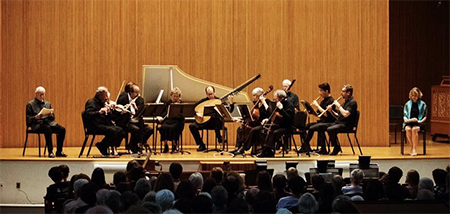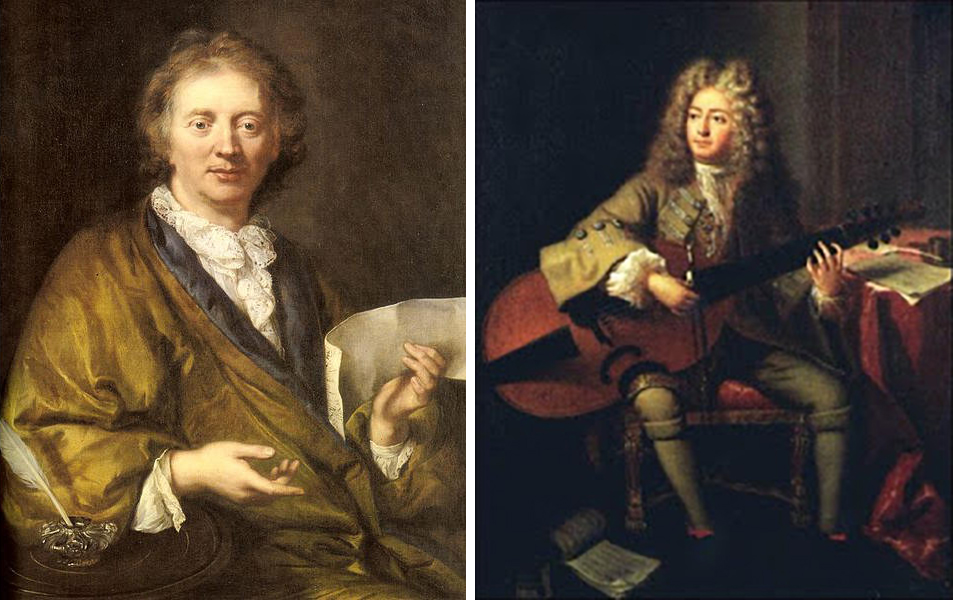by Daniel Hathaway

French Baroque music was the topic of Oberlin’s 2018 Institute, and artistic director Kenneth Slowik used the birth anniversaries of those two composers (Couperin’s 350th and Charpentier’s 375th) as a focal point, bringing Arcangelo Corelli and Jean-Baptiste Lully into the celebration as artistic accomplices.
Corelli and Lully figured in the opening work, Couperin’s L’Apothéose de Lulli, a charming programmatic piece in which Lully is installed on Mount Parnassus amid a bit of stylistic wrangling between the Italian and French muses — the former represented by Corelli. (He received his own apotheosis from Couperin’s pen in an earlier work that was performed on the first BPI faculty concert the previous week.)
As the story unfolded, vivaciously narrated in French by Montréal soprano Susie LeBlanc and wittily translated by baritone Max von Egmond, Apollo brought the two warring factions together, and peace reigned on Parnassus. The succession of short movements and the final serenade were delightfully played by flutists/recordists Christopher Krueger, Michael Lynn, and Peter Lim, oboists Geoffrey Burgess and Lim, violinists Marilyn McDonald and Elizabeth Blumenstock, violist da gamba Catharina Meints, basse de violonist Kenneth Slowik, bassoonist Andrew Schwarz, and harpsichordist Mark Edwards.
A chorus organized by Matthew Robertson was at the core of the ensemble for Charpentier’s Te Deum, H.146, a noble, spacious work whose Prelude has been popularized as Eurovision title music. The flawless playing of trumpeter John Thiessen and the riveting timpanist Matthew Bassett added extra splendor. Sopranos Sophie Caplin, Natalie Ingrisano, and Carter Tholl, countertenors Carter Sligh and James Westerfield, tenors Nathan Dougherty and Grant Yosenick, and baritones Paul Holmes and Ross Tamaccio took stylish turns with the incidental solos, and joined the larger ensemble in energetic choral declamations. Organist Joseph Gascho realized the continuo line with imagination and elegance.

Stage director and choreographer Julie Andrijeski cleverly made much out of little. She passed up costumes, using props to delineate the allegorical characters representing Music (a lyre for Sarah Coffman), Poetry (a feather pen and scroll for Mikayla Jensen-Large), Architecture (a framing square for Veronika Anissimova), Painting (a palette for Carter Sligh), Discord (a lightning bolt for Ross Tamaccio), and Peace (an olive branch for Élodie Bouchard). Two soldiers (Nathan Dougherty and Paul Holmes) brandished swords. Blocking and choreography were simple but elegant — except of course in the case of the furies, who entered the hall from side doors and perfectly embodied chaos and confusion.
As in the original 17th-century production –– when Charpentier himself sang the role of Painting –– the excellent soloists also formed two choruses: the troupe of warriors and the singing furies. Eight dancers, including soloist Natalie Ingrisano, added yet another level of sophistication to the production.
Slowik led the fine “pit” orchestra of flutes and recorders (Christopher Krueger and Michael Lynn), violins (Elizabeth Blumenstock and Jane Starkman), viola da gamba (Lara Turner), cello (Catharina Meints), theorbo and guitar (Lucas Harris), and harpsichord (Lisa Goode Crawford), here deployed in front of the stage.
Les arts florissants, like many extended French Baroque works, ends with a Sarabande en rondeau, this one so lengthy and infectious that you found yourself gliding out of the concert hall in ¾ time, with notes inégals, of course.
Published on ClevelandClassical.com July 3, 2018.
Click here for a printable copy of this article



